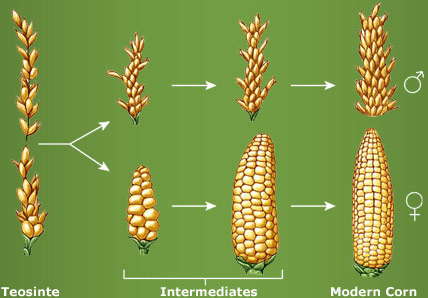What’s a cultivar?
One of the most frequent questions that we get asked in the nursery is “are all of your plants native?” The answer to this is that we carry many native ‘straight species’ and a variety of native cultivars, or ‘nativars’. The straight species is considered the wild type, or the species as you would find it in the wild. A cultivar is a plant that has been specially bred to emphasize specific desirable characteristics. A nativar is simply a cultivar from a straight species/wildtype native plant.
Why breed a cultivar/nativar?
Selective breeding of plants has a long human history both in agriculture and horticultural fields. The very first cultivars were of many ancient crop species, such as corn, which was selectively bred to have larger fruits that made growing them more efficient for harvesting, increased yield, and other features that benefited efficiency. The image below is a simplified diagram showing the steps from breeding ancient corn into todays modern corn.

In a horticultural context, plants are selectively bred to increase their accessibility to gardens and landscapes including functional traits such as disease resistance or longer bloom times. Other features include traits that are more aesthetic from a human perspective such as bloom color, leaf variegation, larger or double flowers, or the overall size and shape of the plant.
Why use nativars instead of straight species?
In some instances, cultivars provide features that enable gardeners or landscapers to use a more native selection than would be available in a traditional commercial nursery market. Dark-leaved Physocarpus opulifolius, for example, can be a great visual alternative to similar colors of Japanese barberry, which is a highly invasive species that can spread to and degrade natural habitats beyond where it is planted. Other reasons might include a dwarf version of a native that are better suited to smaller spaces- a frequent consideration for many home gardeners.
Are there disadvantages to using nativars instead of straight species?
This is where things get complicated, and there has been a lot of discussion and research on this topic. In short, there is not necessarily one definitive answer to this, however in almost all cases the use of nativars is almost without exception a better option than the use of species that are considered invasive or noxious weeds. To provide further insight as to why nativars may be less desirable than straight species, some nativars may provide equal or comparable value for pollination, forage, hydrologic or other ecosystem services, while others may have notably diminished quality for wildlife value and ecosystem services.
Why does Lauren’s Garden Service sell/use nativars?
Working in landscaping and retail nursery industries we realize that shifting the cultural aesthetic to embrace a fully straight species native garden is not a leap that everyone is ready or able to make. Gardens also serve an important role fulfilling needs or desires in our lives beyond solely providing ecological benefit. In light of this, we strive to take a “do no harm” approach and provide a better choice to replace non-native options that meet a customer’s aesthetic goals.
Overall, our current approach is to offer a variety of options, including both straight species and nativars, and to encourage the selection of native plants in any form over invasive or aggressive non-natives. In most instances, we limit our sale of nativars to those that retain the beneficial characteristics of the straight species while offering other features that might make them more desirable or accessible to the gardening public. In some instances, we sell or use nativars whose ecological support is potentially diminished from that offered by the straight species, but may offer traits better suited to the preferences of the customer.
Our landscape selection and nursery stock is ultimately guided by our goals and commitment to be an eco-friendly landscaping and nursery service. While there are certainly many ecosystem benefits to planting with all native straight species, many times geography, space, design preferences, or availability make this impractical in all circumstances. The development of cultivars and nativars has vastly expanded the ability of gardeners and landscapers to utilize species that more closely reflect the natural environment and retain many if not all of the ecosystem services found in the straight species.
Our commitment…
We continue to monitor the ongoing conversation and research in the horticultural community such as the Chicago Botanic Garden’s “Budburst” citizen-science program and Mt. Cuba’s ongoing studies with renowned entomologist Dr. Doug Tallamy, University of Delaware Professor. As this conversation evolves we will continue to modify our practices and plant selection to best reflect our ‘do no harm’ values that simultaneously meet the needs of local gardeners to create beautiful and inviting spaces for their homes and businesses.
